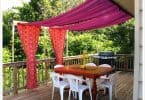 A layman may be surprised as to why we need eco-friendly techniques to landscape and redesign when we are working on a beautiful garden and a cleaner environment. But there is a mounting realisation that the growing demand for the suburban designed landscape has an adverse impact on the environment. Maintenance often requires immense energy dependence as considerable amount of natural resources is required. Like for instance water is needed to keep them from drying and gasoline is required for the lawn mowers. It is not just about beauty anymore, sustainability is also one factor that is being considered and should be. In this context, it requires preserving natural resources as well as amalgamation of our landscape yards with ecological systems.
A layman may be surprised as to why we need eco-friendly techniques to landscape and redesign when we are working on a beautiful garden and a cleaner environment. But there is a mounting realisation that the growing demand for the suburban designed landscape has an adverse impact on the environment. Maintenance often requires immense energy dependence as considerable amount of natural resources is required. Like for instance water is needed to keep them from drying and gasoline is required for the lawn mowers. It is not just about beauty anymore, sustainability is also one factor that is being considered and should be. In this context, it requires preserving natural resources as well as amalgamation of our landscape yards with ecological systems.
Understanding landscape ecology
Landscape Ecology is the study of natural systems at the small regional scale. Planners use the principals of Landscape Ecology for the land-usage planning process, to build towns and expansion that conserves the nature. However we can adopt a few principles too at yard level. In practical terms, we aim to stay away from designs that depend on an excessive use of energy.
Overuse of chemical fertilizers, herbicides and pesticides might penetrate into water supplies and can be harmful. So try to use as much compost or organic substitutes instead. The new inclination towards ecological landscaping and organic lawns are reducing the damaging effects.
Plant native plants and choose species that are locally spread
The widely decorative lawns, from an ecological view, have plants not native to this continent and play no role in providing food or shelter to native birds. It is advisable that you stick to native plants as they grow without much nourishment from other resources and are self-dependent given the climatic conditions. Non-invasive species from other parts are suitable in the proper environmental setting. Choose species that are locally spread and an assortment that are pest and drought resistant, precluding the need for rigorous watering. Another innovative way is to grow plants which do not need water. Cactus in the corners of the lawn is a great idea.
Create your own buffer zones
There is the concept of buffer zones and open space to allow wildlife corridors and bird habitats. Leaving a subdivision of natural invites in birds and other beneficial insects, reducing the amount of grass to water and mow. If you cannot do away with an all grass lawn, you can choose organic methods that perform like chemicals. Test any remedy on a patch before applying it to your yard. Also, stop over watering your lawns. Grass will not die. When it rains, it will be green again.
We can also design in a way such that about three quarters of our lawn is replaced by a garden of native grasses and wildflowers. There is more plant diversity and habitat. There can be a space for storm water to be slowed and allowed to infiltrate. Because of the reduction in lawn mowing costs, it is cheaper to maintain.
Energy conservation, water distribution through integrated systems, and scheming sustainable plant communities are essential workings of our design. We strive to attain a compromise between the needs of nature and people’s affinity to decoration in a given area. We can create harmony with simple principles. It is still beautiful albeit kind to earth.
This guest post is written by Chase Cullen. He is a specialist in landscaping design and maintenance. He writes home improvement and gardening related articles in free time.
Latest posts by Canadian Home Trends (see all)
- Layer Up – Wrap Your Bathroom In Light - December 27, 2025
- The Power of Rest: Elevate Your Wellness with Better Sleep - December 27, 2025
- VERSATILE KITCHEN DESIGN - December 27, 2025






